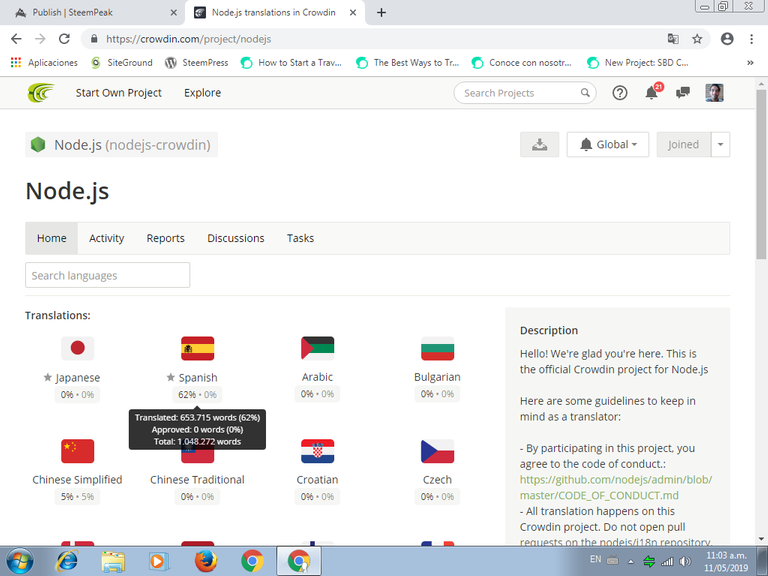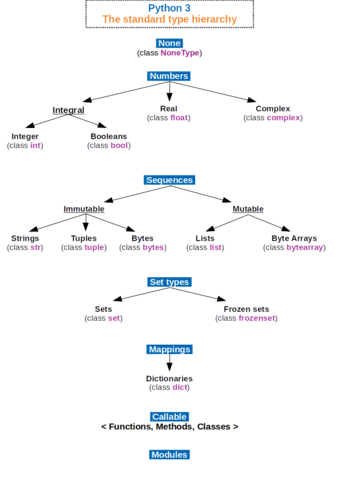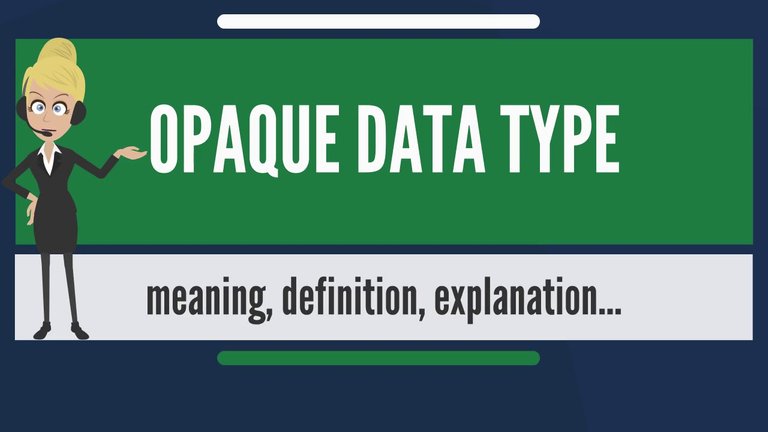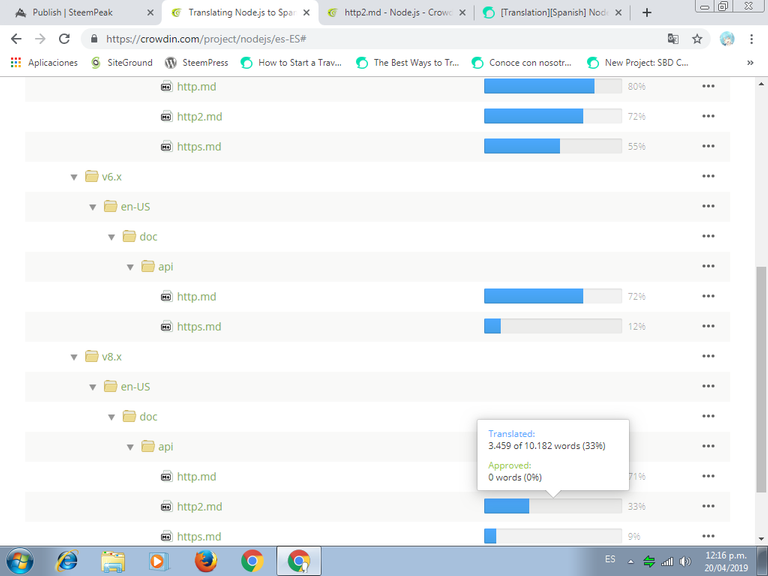
Project Details

Node.js is an open-source, cross-platform JavaScript run-time environment that executes JavaScript code outside the browser.
Node.js brings event-driven programming to web servers, enabling development of fast web servers in JavaScript. Developers can create highly scalable servers without using threading, by using a simplified model of event-driven programming that uses callbacks to signal the completion of a task. Node.js connects the ease of a scripting language (JavaScript) with the power of Unix network programming.
In easier to understand words: Node-js is a free platform whose goal is to provide its users the possibility to create lightweight and cost efficient web servers, how does Node.js do this?
Node.js handles web server connections in a way so they don´t take up as much space in a server, and thus, the owner of a project would not need to invest as much money in multiple servers to store so much information in Gigabytes.
Being an Open Source Project, Node.js possesses immense value for providing so much while at the same time being totally free.
Contribution Specifications
653,715 words have been translated so far in the Spanish folder of Node.js, which amounts to a total of 62% done in regards to the completion of the translation of this big project.
Translation Overview
In this contribution, I continued translating the second http2.md folder of Node.js.
"HTTP/2" stands for "Hypertext Transfer Protocol, version 2", which refers to the network protocol used by the World Wide Web, created with the goal of updating the HTTP/1.1 protocol.
HTTP 2.0 doesn't modify the application semantics of HTTP. All of the basic concepts, such as the HTTP methods, status code, URI, and header fields stay unmodified; however, HTTP 2.0 introduces countless updates such as the usage of a single connection, header compression and the ‘server push’ service.
One of the relevant changes introduced by HTTP 2.0 is the removal of redundant information, whose objective is to avoid sending repetitive data during the same connection; thus resulting in decreased consumed resources, achieving less amounts of latency.
According to W3Techs, as of March 2019, 33.9% of the top 10 million websites supported HTTP/2.
In this contribution I found several strings that explain how events interact with each other and with other values:
ENGLISH (1): The given <0>callback</0> is registered as a listener on the <0>'timeout'</0> event.
SPANISH (1): El <0>callback</0> dado está registrado como un listener en el evento <0>'timeout'</0> .
ENGLISH (2): If the event is not associated with a stream, the <0>Http2Session</0> will be shutdown immediately following the <0>'frameError'</0> event.
SPANISH (2): Si el evento no está asociado con un stream, la <0>Http2Session</0> se cerrará inmediatamente después del evento <0>'frameError'</0> .
ENGLISH (3): The <0>'connect'</0> event is emitted once the <0>Http2Session</0> has been successfully connected to the remote peer and communication may begin.
SPANISH (3): El evento <0>'connect'</0> se emite una vez que la <0>Http2Session</0> ha sido conectada exitosamente al peer remoto y la comunicación pueda comenzar.
ENGLISH (4): The <0>'socketError'</0> event is emitted when an <0>'error'</0> is emitted on the <0>Socket</0> instance bound to the <0>Http2Session</0>.
SPANISH (4): El evento de <0>'socketError'</0> se emite cuando un <0>'error'</0> es emitido en la instancia del <0>Socket</0> vinculado a la <0>Http2Session</0>.
Examples of short sentences I translated:
ENGLISH (1): Event: 'remoteSettings'
SPANISH (1): Evento: 'remoteSettings'
ENGLISH (2): An integer identifying the error code.
SPANISH (2): Un entero que identifica el código de error.
ENGLISH (3): Http2Session and Sockets
SPANISH (3): Http2Session y Sockets
There were also numerous events that reference API interactions:
ENGLISH (1): Once a <0>Socket</0> has been bound to an <0>Http2Session</0>, user code should rely solely on the API of the <0>Http2Session</0>.
SPANISH (1): Una vez que un <0>Socket</0> haya sido vinculado a una <0>Http2Session</0>, el código de usuario debería depender únicamente de la API de la <0>Http2Session</0>.
ENGLISH (2): The <0>http2</0> Core API is much more symmetric between client and server than the <0>http</0> API.
SPANISH (2): La API de Núcleo <0>http2</0> es mucho más simétrica entre cliente y servidor que la API <0>http</0> .
ENGLISH (3): It is specifically <0>not</0> designed for compatibility with the existing <1>HTTP/1</1> module API.
SPANISH (3): <0>No</0> está específicamente diseñada para la compatibilidad con la API existente del módulo <1>HTTP/1</1> .
The new concepts I learned about while working on this subfolder were Data Types and Opaque Data Types:
Data Types are data attributes that indicate and inform the computer and the programmer about the class of data that is going to be handled. This includes imposing restrictions on the data; such as the values that they are able to take, and the operations that they can perform.
The most common Data Types are: integers, booleans, floating-point numbers and alphanumeric strings.
In this example, you can see a simplified explanation of the multiple Data Types that exist:

References for the Data Types concept
Of course, with so many different concepts and Data Types being shown, one could get curious about learning more about them.
For now in this translation report, I will proceed to explain the second concept I learned related to Data Types: Opaque Data Types, and in subsequent reports I will further explain the other Data Types that were shown in the picture.

Opaque Data Types are atomic data that the user defines for database usage.
Being user-defined, these data types contain built-in data that is fully encapsulated, and because of this the internal structure of an opaque data type is unknown to the database server.
The built-in data types BLOB, BOOLEAN, CLOB, BSON, JSON, and LVARCHAR are implemented as opaque data types.
The internal structure of an opaque type is not visible to the database server and can only be accessed through user-defined routines.
Typical examples of opaque data types include handles for resources provided by an operating system to application software. For example, the POSIX standard for threads defines an application programming interface based on a number of opaque types that represent threads or synchronization primitives like mutexes or condition variables.
References for this concept: 1. 2. 3.
Words translated so far on http2.md

Here's the link to the http2.md folder:
Languages
The project's source language is English and it is being translated into Spanish.
Also, Node.js is currently being translated into other 32 languages. I´m contributing to making this project accessible to the Spanish speaking community online.
Besides collaborating as a translator for Open Source Projects on Crowdin I also work as a Freelance Translator for a law firm in the US, I've been working for that company for one year and five months, translating sworn statements and legal documents from English to Spanish and viceversa.
Open Source Projects I've worked on and contributed to as a translator:
5 . Node.js
Word Count
Part 1: 1016; Part 2: 1026; Part 3: 1035; Part 4: 1092; Part 5: 1050; Part 6: 1147; Part 7: 1133; Part 8: 1049; Part 9: 1090; Part 10: 1093; Part 11: 1024; Part 12: 1102; Part 13: 1085; Part 14: 1049; Part 15: 1035; Part 16: 1059; Part 17: 1041; Part 18: 1114; Part 19: 1114; Part 20: 1033; Part 21: 1030; Part 22: 1059; Part 23: 1047; Part 24: 1070; Part 25: 1151; Part 26: 1039; Part 27: 1025; Part 28: 1035; Part 29: 1063; Part 30: 1037; Part 31: 1047; Part 32: 1023; Part 33: 1041; Part 34: 1064; Part 35: 1060; Part 36: 1052; Part 37: 1055; Part 38: 1064; Part 39: 1066; Part 40: 1071; Part 41: 1051.
Total of words translated so far: 43474.
Proof of Authorship
This translation contribution was submitted via Crowdin on March 17th and March 19th.
For further Proof of Authorship in regards to this contribution you can see my activity on Crowdin here.
In case this information would be of interest for the @utopian-io and the @davinci.witness staff, I hereby notify the following:
The nationwide blackouts that have occured and continue to occur in Venezuela have greatly affected my availability to work and contribute as a translator.
I hope I can continue to maintain a constant workflow of contributions. I extend my gratitude to my community managers and my language managers for being so understanding with my situation and the time I was unable to work due to the aforementioned issues.
Thank you @utopian-io, @davinci.witness.
José.
Greetings, @elpoliglota. Thanks for submitting your contribution!
Congratulations on this collaboration!
Your contribution has been evaluated according to Utopian policies and guidelines, as well as a predefined set of questions pertaining to the category.
To view those questions and the relevant answers related to your post, click here.
Chat with us on Discord
Thank you for your review, @alejohannes! Keep up the good work!
Hey, @elpoliglota!
Thanks for contributing on Utopian.
We’re already looking forward to your next contribution!
Get higher incentives and support Utopian.io!
SteemPlus or Steeditor). Simply set @utopian.pay as a 5% (or higher) payout beneficiary on your contribution post (via
Want to chat? Join us on Discord https://discord.gg/h52nFrV.
Vote for Utopian Witness!
Hi @elpoliglota!
Feel free to join our @steem-ua Discord serverYour post was upvoted by @steem-ua, new Steem dApp, using UserAuthority for algorithmic post curation! Your post is eligible for our upvote, thanks to our collaboration with @utopian-io!